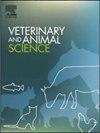Foraging preferences of dairy cows grazing on contrasted multispecies swards
IF 1.9
Q2 AGRICULTURE, DAIRY & ANIMAL SCIENCE
引用次数: 0
Abstract
Selective foraging has been reported in many wild and domesticated ruminants, yet modern livestock production systems rarely allow animals to express this natural behaviour. However, it is assumed that giving livestock the opportunity for forage selection positively influences their health and welfare. This study investigated the forage selection of individual dairy cows on pasture. Over one grazing season, a herd of 23 dairy cows was observed grazing on an experimental pasture in Switzerland, which consisted of different plant mixtures. The cows had unrestricted access to all mixtures and their individual foraging behaviour was documented by scan sampling. The four mixtures were rich in grasses (G), grasses and legumes (L), grasses and tanniferous plants (T), and grasses and herbs containing essential oils (E). The results revealed a partial preference for the L mixture at herd level across all grazing rotations (P ≤ 0.001). All mixtures were frequented, indicating that the herd utilized the array of available plants. Individual preferences varied and not all cows followed the herd's average pattern. Individual preferences shifted throughout the grazing season, but the pattern of this variability differed between animals. The findings demonstrate that dairy cows actively select from different pasture plants and that preferences vary between individuals and over time. Importantly, average herd preferences do not accurately represent the behaviour of all cows. Individual preferences should be considered when aiming to meet the foraging needs of all herd members.
在多种草地上放牧奶牛的觅食偏好
据报道,许多野生和驯养的反刍动物都有选择性觅食,但现代畜牧生产系统很少允许动物表现出这种自然行为。然而,假设给牲畜选择饲料的机会对它们的健康和福利有积极的影响。本研究对牧场上奶牛个体的饲料选择进行了研究。在一个放牧季节,在瑞士的一个由不同植物混合物组成的实验牧场上,观察到一群23头奶牛在放牧。奶牛可以不受限制地接触所有混合物,并且通过扫描抽样记录了它们的个体觅食行为。4种组合均富含禾草(G)、禾草与豆科植物(L)、禾草与单宁植物(T)以及含精油的禾草与草本植物(E)。结果表明,在所有放牧轮作中,L组合在牧群水平上都有部分偏好(P≤0.001)。所有的混合物都是经常出现的,这表明畜群利用了一系列可用的植物。个体偏好各不相同,并不是所有的奶牛都遵循牛群的平均模式。个体偏好在整个放牧季节发生变化,但这种变化的模式在动物之间有所不同。研究结果表明,奶牛积极地从不同的牧草植物中进行选择,这种偏好在个体和时间之间是不同的。重要的是,平均牛群偏好并不能准确地代表所有奶牛的行为。在满足所有兽群成员的觅食需求时,应考虑个体偏好。
本文章由计算机程序翻译,如有差异,请以英文原文为准。
求助全文
约1分钟内获得全文
求助全文
来源期刊

Veterinary and Animal Science
Veterinary-Veterinary (all)
CiteScore
3.50
自引率
0.00%
发文量
43
审稿时长
47 days
 求助内容:
求助内容: 应助结果提醒方式:
应助结果提醒方式:


